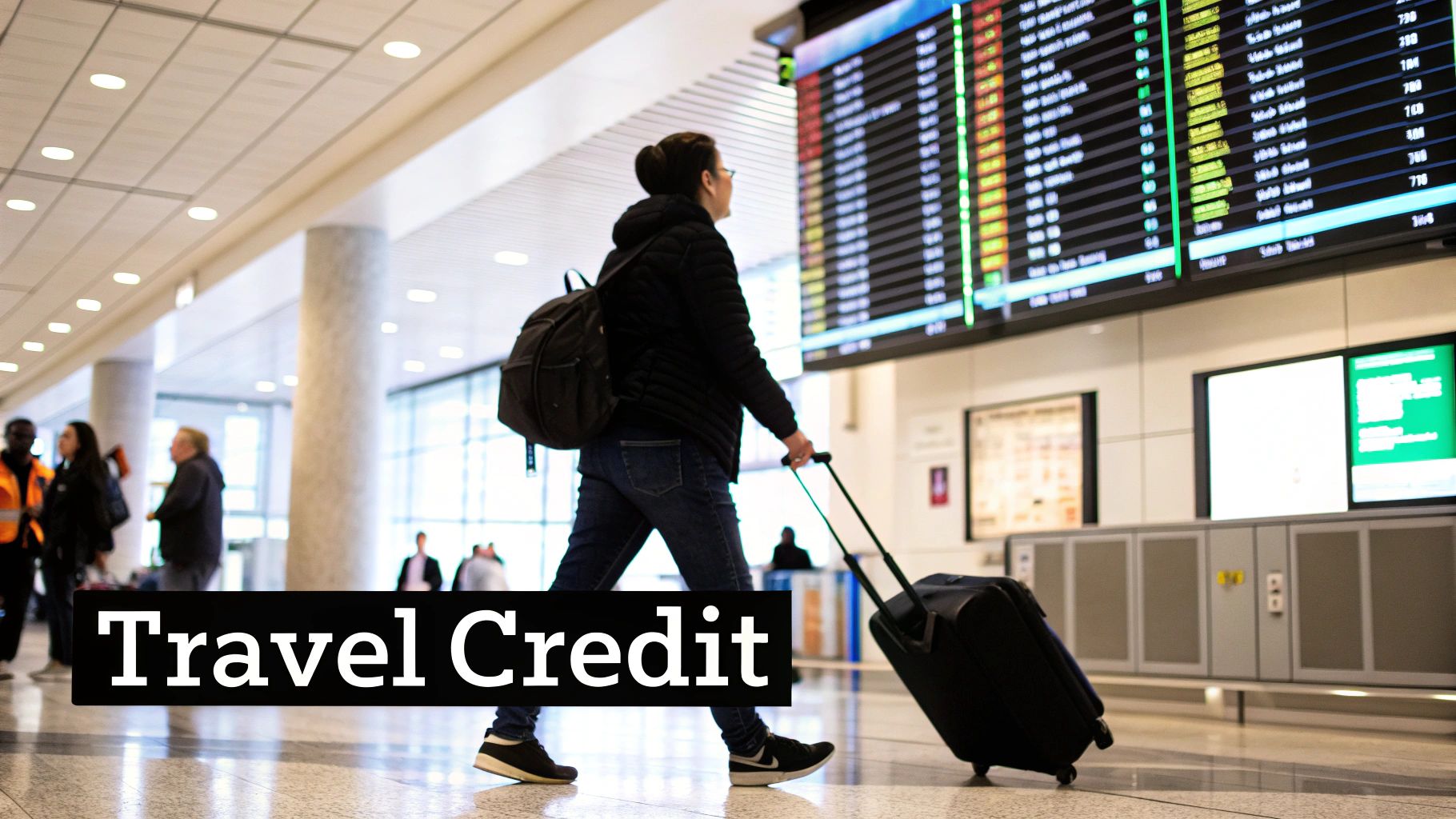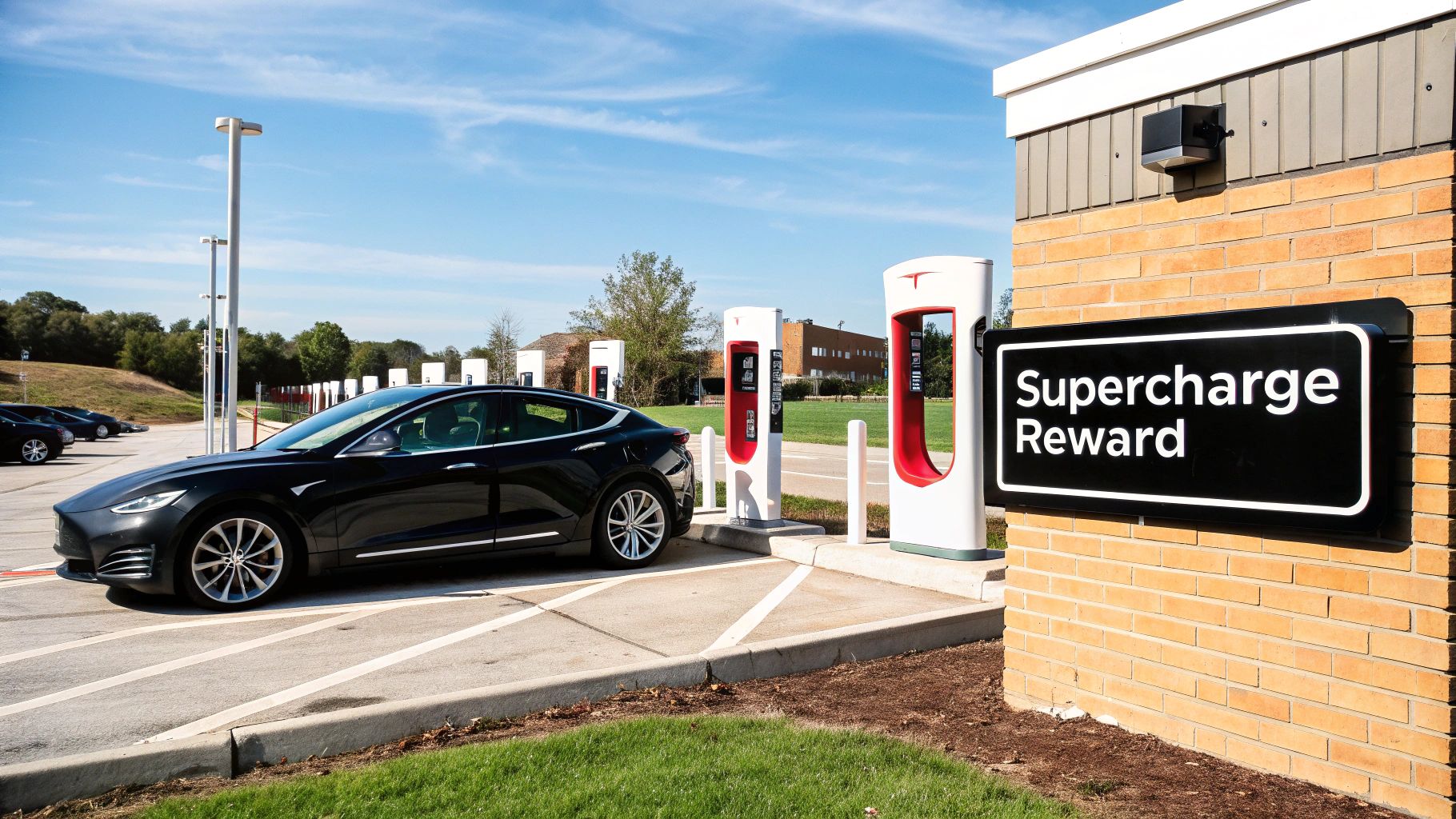Unlocking Explosive Growth: Learning from the Best SaaS Referral Programs
Referral marketing is a powerful growth engine for SaaS. This listicle dissects ten proven SaaS referral program examples, offering actionable takeaways to ignite your growth. We'll analyze the mechanics and incentives behind their success, providing strategic insights you can apply regardless of your company’s size.
Want to supercharge your customer acquisition? Referral programs leverage the trust of existing customers, transforming them into enthusiastic advocates. This translates into lower customer acquisition costs (CAC), higher customer lifetime value (CLTV), and accelerated growth.
We'll explore diverse referral program examples, including Dropbox's storage bonus, Uber's ride credits, Airbnb's travel credits, Tesla's unique rewards, PayPal's cash incentives, Morning Brew's milestone system, Amazon Prime's member benefits, and Glossier's community-focused approach.
These examples demonstrate the power of well-designed referral programs. They offer a blueprint for building your own successful program.
Managing your referral program effectively is crucial for maximizing results. If you're looking for tools to help manage your referral program, consider exploring options like this: Referral Program from Octolens.
We'll delve into the strategies behind these referral programs, highlighting:
- Incentive structures: What motivates users to refer?
- Program mechanics: How simple is the referral process?
- Key takeaways: What made these programs successful?
This listicle provides a practical roadmap to building a high-performing referral program. Get ready to unlock exponential growth.
1. Dropbox's Storage Bonus Program
Dropbox's referral program is a classic example of a two-sided incentive program done right. It fueled the company's explosive growth in its early days and remains a key component of its acquisition strategy. The program's premise is simple: both the referrer and the referred user receive extra storage space upon successful signup. This reward directly aligns with Dropbox's core value proposition - more storage.
This strategy cleverly leveraged the inherent virality of needing to share files with others. When users ran out of space, the incentive to invite friends became even stronger. Understanding how other companies have successfully positioned their brands can provide valuable inspiration. Consider these top brand positioning examples. Dropbox brilliantly positioned itself as the go-to file storage and sharing solution by making the act of sharing integral to earning more space.
Results and Key Takeaways
The program's impact was remarkable. Dropbox achieved 35% month-over-month growth, largely attributed to referrals. They grew from 100,000 users to a staggering 4 million in just 15 months. In the first 30 days alone, over 2.8 million referral invitations were sent. The following infographic visualizes Dropbox's user growth and the sheer volume of referral invitations generated in the initial launch phase.

The line graph clearly demonstrates the rapid growth of users over 15 months, while the bar chart highlights the substantial number of referrals generated in the first month. This data underscores the power of a well-executed referral program in driving user acquisition. Learn more about Dropbox's Storage Bonus Program.
Actionable Tips for Your Referral Program
- Relevance is Key: Ensure your reward directly relates to your product’s core value. This creates a strong incentive for both the referrer and the referee.
- Simplicity is Crucial: Make the referral process as simple as possible. Complicated processes lead to drop-offs and reduce participation.
- Set Limits: Implement reasonable caps on referral bonuses to prevent abuse while still maintaining motivation. Dropbox's 16GB limit strikes a good balance.
- Seamless Integration: Integrate referral prompts naturally into the user workflow. Trigger prompts at logical points, like when a user shares a file or reaches their storage limit. This makes the referral process feel organic rather than intrusive. This is a powerful example of using a referral program as a core growth lever.
2. Uber's Ride Credit System
Uber's referral program is a prime example of leveraging a two-sided incentive to drive rapid growth in a network-based business. It rewards both the referrer and the referred friend with ride credits upon successful signup and first ride completion. This simple yet powerful mechanism has been instrumental in Uber's global expansion. The specific credit amounts vary based on market and ongoing promotions, providing flexibility.
This strategy capitalized on the inherent social nature of transportation. People often discuss their travel plans and experiences, creating natural opportunities for referral conversations. When someone needs a ride, a readily available discount provides a strong incentive to try Uber. This incentivizes not just new user acquisition but also repeated usage. Learn from other top brand positioning examples and apply the principles to your referral program.
Results and Key Takeaways
Uber's referral program is considered a significant factor in its expansion to over 70 countries and its impressive growth trajectory. In early expansion phases, the program contributed to growth rates exceeding 50%. It also generated millions of new user acquisitions worldwide. This organic growth strategy proved incredibly efficient compared to traditional marketing channels.
The success is attributable to the direct correlation between the reward and the service offered. This alignment creates a compelling value proposition for both parties. Additionally, the program's simplicity contributes to high participation rates. Although no specific infographic is available to showcase Uber's exact referral data, the company's widespread adoption speaks volumes about the program's effectiveness.
Actionable Tips for Your Referral Program
- Adjust to Local Markets: Tailor reward amounts based on local market conditions and currency values.
- Expiration Dates: Set reasonable expiration dates on ride credits to encourage prompt usage and quicker conversion.
- A/B Testing: Experiment with different reward amounts to optimize your cost per acquisition.
- Create Urgency: Implement limited-time promotional periods to incentivize immediate action.
- Simplicity is King: Keep the referral process simple and user-friendly. A complex process can deter participation. This reinforces how a simple, relevant referral program can serve as a potent growth engine.
3. Airbnb's Travel Credit Program
Airbnb's referral program is a prime example of leveraging the sharing economy to drive growth. It offers travel credits to both new and existing users. New users receive a credit towards their first booking after signing up through a referral link. Existing users earn credits when their referrals complete their first stay or host their first guest. This dual-sided incentive structure encourages both customer and host acquisition.

This strategy taps into the inherent social nature of travel. People often discuss and recommend travel experiences with friends and family. By offering a tangible reward, Airbnb incentivizes these recommendations and turns them into concrete bookings. The program played a significant role in Airbnb’s expansion to over 4 million listings in 220+ countries and regions.
Results and Key Takeaways
While specific figures aren't publicly available, the program undeniably contributed to Airbnb's explosive growth. It facilitated host acquisition in new markets and solidified its position as a leading platform for travel accommodation. The program's success highlights the power of incentivizing word-of-mouth marketing. This approach is especially effective in industries with high social sharing, like travel and hospitality.
Actionable Tips for Your Referral Program
- Set Minimums: Implement minimum booking thresholds to ensure quality referrals and prevent abuse of the system. This ensures a return on investment for each referral credit issued.
- Compelling Rewards: Offer rewards that justify the cost of your service. Travel credits are highly appealing for a platform like Airbnb, aligning directly with the user's needs and desires.
- Social Sharing: Make sharing experiences and referral links easy and social media friendly. Streamline the process to maximize participation and reach a wider audience.
- Fraud Prevention: Track referral activity and implement measures to prevent fraudulent referrals. This protects the program's integrity and ensures sustainable growth.
- Two-Sided Incentives: Consider offering rewards to both referrers and referees to maximize engagement and drive both customer and supplier acquisition, as relevant to your business model. This approach makes the referral program beneficial for all participants.
4. Tesla's Referral Rewards Program
Tesla's referral program stands out as a prime example of leveraging a passionate customer base to drive sales. It's built on offering high-value rewards, ranging from free Supercharging miles to exclusive merchandise and even the chance to win new Tesla vehicles. The program primarily targets existing Tesla owners, encouraging them to refer friends and family to purchase their own electric vehicles. Rewards vary based on the number of successful referrals, creating a tiered system that incentivizes continued participation.

This strategy aligns perfectly with Tesla's brand image of exclusivity and innovation. Just as Tesla uses referrals, Airbnb relies heavily on reviews to build trust, which you can explore further in these Airbnb reviews examples. Both companies understand the power of user-generated content in driving conversions. The allure of exclusive rewards and the inherent desirability of Tesla vehicles create a powerful incentive for both referrers and referees.
Results and Key Takeaways
Tesla's referral program has demonstrably contributed to thousands of vehicle sales. The program has also generated significant viral marketing buzz, particularly when new and exciting rewards are introduced. This, in turn, has strengthened Tesla's brand community and fostered a sense of loyalty among owners.
Actionable Tips for Your Referral Program
- Offer rewards that align with your brand values: Tesla's rewards, like free Supercharging, resonate strongly with their environmentally conscious customer base.
- Create exclusivity to drive participation: Limited-edition merchandise and the chance to win a Tesla vehicle create a sense of urgency and excitement.
- Use gamification to increase engagement: The tiered reward system encourages repeat referrals and fosters friendly competition.
- Leverage your existing passionate customer base: Tesla successfully taps into the enthusiasm of its owners, turning them into brand advocates. This is crucial for driving organic growth through word-of-mouth marketing.
5. PayPal's Cash Reward Program
PayPal's referral program stands as a prime example of using direct cash incentives to drive rapid user acquisition. In its early stages, PayPal leveraged this strategy to quickly expand its user base and solidify its position as a leading online payment platform. The program's core mechanic was straightforward: both the referrer and the referred user received cash bonuses directly into their PayPal accounts after the referred user signed up and completed qualifying activities, such as making a certain number of transactions.
This direct cash reward resonated strongly with users. It offered tangible value and aligned perfectly with PayPal's function as a payment platform. The ease of receiving the reward directly within the PayPal ecosystem further enhanced the program's appeal. The program contributed significantly to PayPal becoming a household name in online payments, generating millions of new account signups. Learn more about similar successful strategies, like the Stripe Referral Program.
Results and Key Takeaways
While precise figures are not publicly available, the program's success is undeniable. It played a pivotal role in PayPal's explosive growth in its formative years, helping it establish a dominant market share. The program's simplicity and direct cash incentive proved highly effective in attracting new users and encouraging existing users to spread the word.
The direct cash reward system provided immediate gratification for both parties, fueling the program's virality. This strategy underscores the power of aligning incentives with the core product offering. PayPal's success demonstrates how a well-structured referral program can be a powerful engine for growth, especially in the early stages of a company's lifecycle.
Actionable Tips for Your Referral Program
- Clear Qualifying Activities: Define specific actions required to trigger the reward. This ensures user engagement and prevents abuse.
- Fraud Prevention: Implement measures to detect and prevent fraudulent referral activity. This protects the integrity of the program.
- Balance Rewards: Carefully consider the reward amount relative to customer lifetime value. The reward should be enticing but sustainable.
- Strategic Timing: Cash rewards can be particularly effective during periods of aggressive growth or market penetration. Consider using them strategically.
- Simple Tracking: Make it easy for users to track their referrals and earned rewards. This encourages ongoing participation.
6. Morning Brew's Milestone Reward System
Morning Brew's referral program is a prime example of how a tiered reward system can effectively incentivize user engagement and drive exponential growth. Instead of offering a single reward, Morning Brew uses a milestone-based approach where subscribers unlock progressively more valuable rewards for each successful referral they generate. This gamified structure creates a sense of accomplishment and encourages continued participation.
This strategy taps into the psychology of achievement and motivates users to strive for higher referral tiers. Rewards range from stickers and mugs for a few referrals to exclusive merchandise, access to private events, and even opportunities to meet the founders for those who reach the top tiers. This clever approach not only incentivizes referrals but also strengthens brand loyalty and fosters a sense of community. The varying reward tiers create a clear path for user progression, keeping them engaged and motivated to invite more friends.
Results and Key Takeaways
Morning Brew's referral program played a crucial role in their rapid growth from 100,000 to over 4 million subscribers. Referrals became a significant driver, contributing over 30% of their overall growth. This demonstrates the power of leveraging a community of brand advocates through a well-structured referral program. The tiered system fosters a sense of friendly competition and encourages users to share the newsletter with their network.
The success of Morning Brew’s strategy showcases how aligning rewards with brand identity can amplify the program's impact. By offering exclusive merchandise and experiences, they strengthened the connection between the brand and its audience, further solidifying the community aspect. This approach effectively turned subscribers into active participants in Morning Brew's growth.
Actionable Tips for Your Referral Program
- Use Milestone Tiers: Implement a tiered reward structure to incentivize multiple referrals. This creates a sense of progression and motivates continued participation.
- Create Rewards that Reinforce Brand Identity: Offer rewards that align with your brand and resonate with your target audience. This strengthens brand affinity and makes the rewards more desirable.
- Make Progress Visible and Shareable: Clearly display referral progress and make it easy for users to share their achievements. This fosters a sense of community and encourages friendly competition.
- Offer Both Digital and Physical Rewards: Provide a mix of digital and physical rewards to cater to different preferences. This increases the appeal of the program and caters to a wider range of user motivations. This multifaceted approach can significantly boost engagement and drive sustainable growth through referrals.
7. Amazon Prime's Referral Benefits
Amazon Prime's referral program cleverly leverages the immense value and loyalty associated with its Prime membership. By incentivizing existing members to refer new subscribers, Amazon fuels continuous growth and strengthens its already dominant market position. The program offers various benefits, including promotional credits, extended trial periods, and special offers, all designed to tap into the inherent desire of Prime members to share the advantages they enjoy. This creates a win-win scenario where both the referrer and the referred user receive tangible rewards.
This strategy is particularly effective because it aligns perfectly with Amazon's overarching goal of expanding its Prime ecosystem. By rewarding existing members, Amazon effectively transforms them into brand ambassadors, driving organic growth and reinforcing the perceived value of Prime membership. Understanding how a referral program can amplify your customer acquisition strategy is crucial for sustainable growth. Learn more about building a successful referral program for SaaS businesses. Amazon's approach demonstrates the power of utilizing an existing customer base to acquire new users.
Results and Key Takeaways
Amazon's referral program has played a significant role in the phenomenal growth of Prime, contributing to a membership base exceeding 200 million globally. This program also facilitated the expansion of Prime into new international markets, demonstrating its adaptability and effectiveness across diverse demographics. Furthermore, by encouraging membership referrals, Amazon has successfully increased customer lifetime value through enhanced membership retention. This strategy effectively strengthens the entire Prime ecosystem.
The program's success highlights the power of leveraging the existing customer base as a growth engine. By turning satisfied customers into advocates, Amazon generates organic referrals that are significantly more cost-effective than traditional advertising. This approach underscores the importance of building a loyal customer base that actively contributes to acquisition efforts.
Actionable Tips for Your Referral Program
- Leverage Existing Benefits: Integrate your referral program with your core product or service offerings. Offer rewards that enhance the user experience, similar to how Amazon uses promotional credits and extended trials.
- Reduce Barriers to Entry: Offer trial periods or freemium versions to new users referred by existing customers. This lowers the barrier to entry and increases the likelihood of conversion.
- Strategic Timing: Utilize promotional periods to boost referral activity. Offer increased rewards or special incentives during peak seasons or product launches to maximize participation.
- Ecosystem Integration: Ensure that referral rewards are usable across your entire ecosystem. This encourages engagement and strengthens customer loyalty within your platform, similar to how Amazon leverages its vast product and service offerings. This creates a powerful incentive for both referring and referred users.
8. Glossier's Community-Driven Program
Glossier's referral program transcends a simple transaction-based system. It cultivates community and brand advocacy through a points-based reward structure. Customers earn points not just for referrals, but also for engaging with the brand across various touchpoints like social media, product reviews, and online community participation. These points are then redeemable for products, early access to new releases, and exclusive experiences.
This strategy cleverly leverages the desire for belonging and recognition within a passionate beauty community. Glossier understands its target audience's inherent love for sharing beauty tips and discoveries. By rewarding this behavior, they've effectively turned their customer base into a powerful marketing engine.
Results and Key Takeaways
Glossier's approach fostered a cult-like following, generating substantial user-generated content and contributing to its rapid growth. The program's success stems from prioritizing community building over mere transactions. This approach effectively transformed customers into brand ambassadors. This, in turn, fueled organic growth and amplified Glossier's message across social media platforms.
The program's emphasis on authentic engagement fostered a genuine sense of community. This differentiated Glossier from competitors relying solely on transactional referral models. The resulting word-of-mouth marketing proved invaluable in establishing Glossier as a leading beauty brand.
Actionable Tips for Your Referral Program
- Build Community First: Focus on creating a thriving community around your brand before implementing a referral program. This fosters a sense of belonging and encourages genuine engagement.
- Reward Authentic Engagement: Don't limit rewards to referrals. Reward various brand interactions to incentivize broader participation and cultivate brand loyalty.
- Make Sharing Valuable: Ensure the rewards are enticing and align with your target audience’s desires. Glossier's offering of exclusive products and experiences resonates strongly with its customer base.
- Leverage Social Proof: Encourage users to share their referral links and experiences on social media. This amplifies the program's reach and leverages social proof to drive further participation. This strategy capitalizes on the power of word-of-mouth marketing within a trusted network.
Referral Program Features Comparison of 8 Examples
| Program | Implementation Complexity 🔄 | Resource Requirements ⚡ | Expected Outcomes 📊 | Ideal Use Cases 💡 | Key Advantages ⭐ |
|---|---|---|---|---|---|
| Dropbox's Storage Bonus Program | Moderate - requires product integration & tracking | Low - storage costs are relatively inexpensive | High user growth via referrals (35% MoM growth) | Digital products with scalable resource-based rewards | Aligned rewards with core product value; incentivizes both parties equally |
| Uber's Ride Credit System | High - includes localized rewards and driver/rider splits | High - ride credits can be costly | Significant user acquisition and market expansion | Services with direct usage incentives and geographic variation | Immediate value for users; flexible & market-adapted rewards |
| Airbnb's Travel Credit Program | High - complex tracking, different reward types | High - costly per acquisition and fraud prevention | Expands both supply and demand; international growth | Platforms with dual-sided market (guests & hosts) | High-value rewards encourage premium bookings; builds trust |
| Tesla's Referral Rewards Program | High - gamification and tiered exclusive rewards | High - expensive to fulfill high-ticket rewards | Drives high-value sales and strong brand loyalty | Premium/high-ticket products with passionate user base | Strong brand advocacy and community engagement |
| PayPal's Cash Reward Program | Moderate - automatic tracking & deposit systems | High - direct cash payouts | Rapid user growth and increased transactions | Financial services needing fast user onboarding | Universal appeal of cash; easy to track and redeem |
| Morning Brew's Milestone Reward System | Moderate - milestone tiers and gamification | Low - mostly low-cost merchandise | Sustained subscriber growth and brand advocacy | Media & Publishing with engaged subscriber base | Creates brand ambassadors with scalable, low-cost rewards |
| Amazon Prime's Referral Benefits | Moderate - integrated with existing membership | Moderate - promotional credits and trials | Growth in membership base and retention | Subscription services with strong value proposition | Leverages existing loyalty; high conversion rates |
| Glossier's Community-Driven Program | High - points system with multiple engagement methods | Moderate - product rewards and community events | Cultivates strong brand community and organic growth | Lifestyle/beauty brands focusing on brand loyalty | Builds authentic advocacy and multi-channel engagement |
Building Your Own Referral Rocket: Key Takeaways and Next Steps
Examining these diverse referral program examples reveals several key ingredients for success. From Dropbox's storage bonus to Glossier's community-driven approach, each program demonstrates the power of leveraging existing customer relationships. These programs also highlight the importance of understanding your target audience and tailoring rewards to their specific needs and desires. By analyzing these successful campaigns, we can distill several actionable takeaways for your own referral program.
Strategic Insights for Referral Program Success
One crucial insight is the importance of simplicity. A complicated referral process can deter even the most loyal customers. Uber's straightforward ride credit system exemplifies this principle, offering a seamless experience for both referrer and referred friend. Another key element is the choice of incentive. The reward must be valuable enough to motivate action. Tesla’s referral program, with its attractive rewards like free Supercharging, demonstrates the allure of a high-value incentive.
Actionable Steps for Implementation
Start by clearly defining your target audience and their motivations. What would truly incentivize them to refer your product or service? Consider a tiered reward system, like Morning Brew's milestone program, to encourage continued referrals. Ensure your referral process is easy to understand and execute, mimicking the simplicity of PayPal's cash reward system.
Leveraging Existing Customer Relationships
The success stories highlighted here emphasize the power of tapping into your existing customer base. These satisfied users are your biggest advocates. By providing them with the right tools and incentives, you can transform them into a powerful growth engine for your business. Amazon Prime’s referral benefits, offering advantages to both parties, showcase this effectively.
Why Mastering Referral Programs Matters
Mastering the art of referral marketing is crucial for sustainable SaaS growth, particularly for early-stage startups, self-serve SaaS companies, and those focused on product-led growth. Referrals are a cost-effective way to acquire new customers who are often more engaged and have higher lifetime value. Building a strong referral program can significantly impact your bottom line and contribute to long-term success. Think about how Airbnb’s travel credit program leverages the excitement of travel to drive referrals.
By implementing the strategies gleaned from these referral program examples, you can unlock the immense potential of your customer base. Remember, the key is to create a program that is simple, rewarding, and easy to share. This approach, combined with a deep understanding of your target audience, will propel your referral program to new heights.
Want to streamline your referral program and unlock its full potential? Refgrow simplifies the complexities of managing and scaling referral programs, allowing you to easily implement the winning strategies discussed here. Visit Refgrow to learn how Refgrow can help you build and optimize your own high-performing referral program, drawing inspiration from successful referral program examples like those highlighted in this article.

